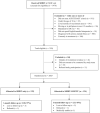Using recovery management checkups for primary care to improve linkage to alcohol and other drug use treatment: a randomized controlled trial three month findings
- PMID: 36208061
- PMCID: PMC10015976
- DOI: 10.1111/add.16064
Using recovery management checkups for primary care to improve linkage to alcohol and other drug use treatment: a randomized controlled trial three month findings
Abstract
Background and aims: Recovery management checkups (RMC) have established efficacy for linking patients to substance use disorder (SUD) treatment. This study tested whether using RMC in combination with screening, brief intervention, and referral to treatment (SBIRT), versus SBIRT alone, can improve linkage of primary care patients referred to SUD treatment.
Design: A randomized controlled trial of SBIRT as usual (n = 132) versus SBIRT plus recovery management checkups for primary care (RMC-PC) (n = 134) with follow-up assessments at 3 months post-baseline.
Setting: Four federally qualified health centers in the United States serving low-income populations.
Participants: Primary care patients (n = 266, 64% male, 80% Black, mean age, 48.3 [range, 19-53]) who were referred to SUD treatment after SBIRT.
Interventions: SBIRT alone (control condition) compared with SBIRT + RMC-PC (experimental condition).
Measurement: The primary outcome was any days of SUD treatment in the past 3 months. Key secondary outcomes were days of SUD treatment overall and by level of care, days of alcohol and other drug (AOD) abstinence, and days of using specific substances, all based on self-report.
Findings: At 3-month follow-up, those assigned to SBIRT + RMC-PC (n = 134) had higher odds of receiving any SUD treatment (46% vs 20%; adjusted odds ratio = 4.50 [2.49, 8.48]) compared with SBIRT only, including higher rates of entering residential and intensive outpatient treatment. They also reported more days of treatment (14.45, vs 7.13; d = +0.26), more days abstinent (41.3 vs 31.9; d = +0.22), and fewer days of using alcohol (27.14, vs 36.31; d = -0.25) and cannabis (19.49, vs 28.6; d = -0.20).
Conclusions: Recovery management checkups in combination with screening, brief intervention, and referral to treatment are an effective strategy for improving linkage of primary care patients in need to substance use disorder treatment over 3 months.
Trial registration: ClinicalTrials.gov NCT03746756.
Keywords: Federally qualified health centers (FQHC); Linkage to treatment; Pimary Care; recovery management checkups (RMC); screening brief intervention and referral to treatment (SBIRT); substance use disorders.
© 2022 The Authors. Addiction published by John Wiley & Sons Ltd on behalf of Society for the Study of Addiction.
Conflict of interest statement
None.
Figures


Similar articles
-
Exploring the feasibility of Recovery Management Checkups for Primary Care in a Federally Qualified Health Center.Front Public Health. 2024 Nov 11;12:1443409. doi: 10.3389/fpubh.2024.1443409. eCollection 2024. Front Public Health. 2024. PMID: 39588163 Free PMC article.
-
A randomized controlled trial of recovery management checkups for primary care patients: Twelve-month results.Alcohol Clin Exp Res (Hoboken). 2023 Oct;47(10):1964-1977. doi: 10.1111/acer.15172. Epub 2023 Oct 17. Alcohol Clin Exp Res (Hoboken). 2023. PMID: 37864532 Free PMC article.
-
Linking Individuals with Substance Use Disorders (SUDs) in Primary Care to SUD Treatment: the Recovery Management Checkups-Primary Care (RMC-PC) Pilot Study.J Behav Health Serv Res. 2018 Apr;45(2):160-173. doi: 10.1007/s11414-017-9576-5. J Behav Health Serv Res. 2018. PMID: 29181779 Free PMC article.
-
Screening and brief intervention for alcohol and other abuse.Adolesc Med State Art Rev. 2014 Apr;25(1):126-56. Adolesc Med State Art Rev. 2014. PMID: 25022191 Review.
-
Screening, Brief Intervention and Referral to Treatment (SBIRT): rationale, program overview and cross-site evaluation.Addiction. 2017 Feb;112 Suppl 2:3-11. doi: 10.1111/add.13676. Addiction. 2017. PMID: 28074566 Review.
Cited by
-
Associations between clinical AUDIT-C screens and HDL cholesterol are observed across primary care patient subgroups.Alcohol Clin Exp Res (Hoboken). 2025 May;49(5):1106-1116. doi: 10.1111/acer.70038. Epub 2025 Mar 28. Alcohol Clin Exp Res (Hoboken). 2025. PMID: 40156082
-
Exploring the feasibility of Recovery Management Checkups for Primary Care in a Federally Qualified Health Center.Front Public Health. 2024 Nov 11;12:1443409. doi: 10.3389/fpubh.2024.1443409. eCollection 2024. Front Public Health. 2024. PMID: 39588163 Free PMC article.
-
A randomized controlled trial of recovery management checkups for primary care patients: Twelve-month results.Alcohol Clin Exp Res (Hoboken). 2023 Oct;47(10):1964-1977. doi: 10.1111/acer.15172. Epub 2023 Oct 17. Alcohol Clin Exp Res (Hoboken). 2023. PMID: 37864532 Free PMC article.
References
-
- Forouzanfar MH, Afshin A, Alexander LT, Biryukov S, Brauer M, Cercy K, et al. Global, regional, and national comparative risk assessment of 79 behavioural, environmental and occupational, and metabolic risks or clusters of risks, 1990–2015: A systematic analysis for the global burden of disease study 2015. Lancet. 2016;388(10053):1659–724. 10.1016/S0140-6736(16)31679-8 - DOI - PMC - PubMed
-
- Vigo DV, Kestel D, Pendakur K, Thornicroft G, Atun R. Disease burden and government spending on mental, neurological, and substance use disorders, and self‐harm: Cross‐sectional, ecological study of health system response in the Americas. Lancet Public Health. 2019;4(2):e89–96. 10.1016/S2468-2667(18)30203-2 - DOI - PubMed
-
- SAMHSA . Key substance use and mental health indicators in the United States: Results from the 2019 national survey on drug use and health (HHS publication no. PEP20‐07‐01‐001, NSDUH series H‐55) [internet]. Rockville, MD; 2020. Available from: https://www.samhsa.gov/data/
-
- Services C for M and M. Federally Qualified Health Center: Fact Sheet.
Publication types
MeSH terms
Substances
Associated data
Grants and funding
LinkOut - more resources
Full Text Sources
Medical
Miscellaneous

